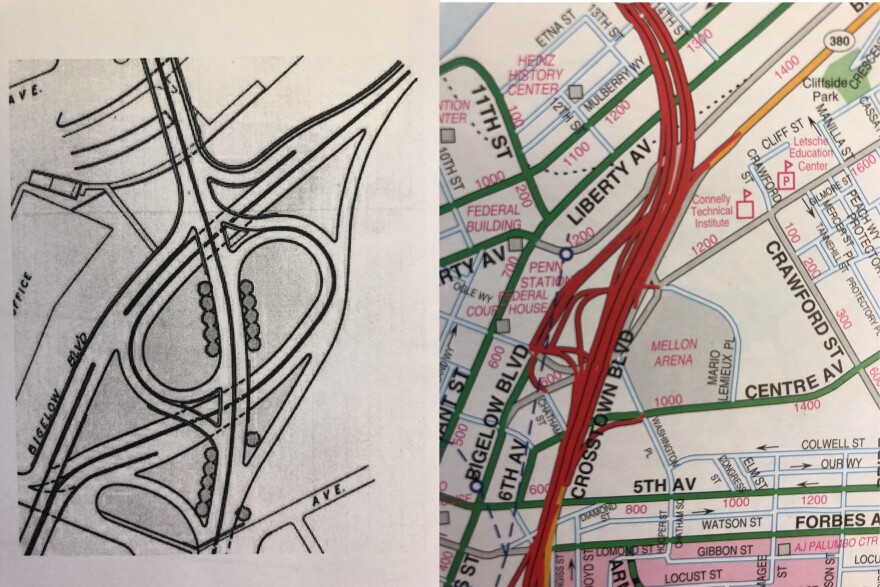While drivers won't find a poltergeist hanging out on the 100-foot long abandoned on-ramp that sneaks up on drivers heading east on Bigelow Boulevard, they might spot trees and shrubs sprouting through concrete in spite of heavy barriers.
Good Question! listener Elizabeth Marshall from Mount Lebanon commutes on Bigelow each morning and always wondered about the spooky thoroughfare.
“It’s very apocalyptic,” said Marshall. “I thought it is strange when you come from [Interstate] 279 or across the Veterans Bridge, you can’t get onto that at all.”

Only half-constructed, the ramp doesn’t connect to any other streets. It appears to emerge from a towering concrete wall and then dissolve into the boulevard’s two eastbound lanes.
This ramp once had a future, according to PAHighways.com webmaster Jeff Kitsko. It was going to be part of a traffic-circle-like design linking I-579, or Crosstown Boulevard, and I-376, or the Parkway. Planning for Crosstown Boulevard began in the 1960s, when engineers wanted I-376 and I-279 to connect.
Original proposals for the “Crosstown Improvement” were submitted as part of a larger “Arterial Plan for Pittsburgh’ project by urban development consultant Robert Moses. He’s the same developer critics have said ignored the African American community living in the Lower Hill District, when they voiced concerns about how construction would affect their neighborhoods.

What appear as overlapping layers of on- and off-ramps weave between major byways in Moses’ sketches of Crosstown Boulevard. Beside each lane, he included room for gardens and landscaping. Had it been constructed, drivers could have traveled from the present home of Pittsburgh's hockey arena straight to Bigelow or the Veterans Bridge and avoid Downtown traffic.
This is part of our Good Question! series where we investigate what you've always wondered about Pittsburgh, its people and its culture.
Decades later when the state Department of Transportation, the U.S. Department of Highways and the city determined what they could collectively afford to construct, Kitsko said the ramp was one of the first ideas to go.
“The way they see it, that’s another ‘$X million’ off of the project,” Kitsko said.
I-279 expressway plans also included HOV lanes; restricted traffic begins at Bedford Avenue.
“So with the construction of that, the ramps to and from 579 and Bigelow Boulevard were eliminated,” Kitsko said.

Crews turned their focus to planning for the Veterans Bridge, which wouldn’t be completed until 1988.
The ghost ramp remains untouched and unused, but it’s not the only abandoned Pittsburgh transit project. Chris Sandvig, research analyst with Pittsburgh Community Reinvestment Group, said on the Birmingham Bridge, half-constructed ramps were originally designed for a freeway system connecting East Carson, Oakland and the South Hills.
“There was a wholehighway network that was put forward ... and never got built,” Sandvig said. “The ramps are a relic of that.”'
_






